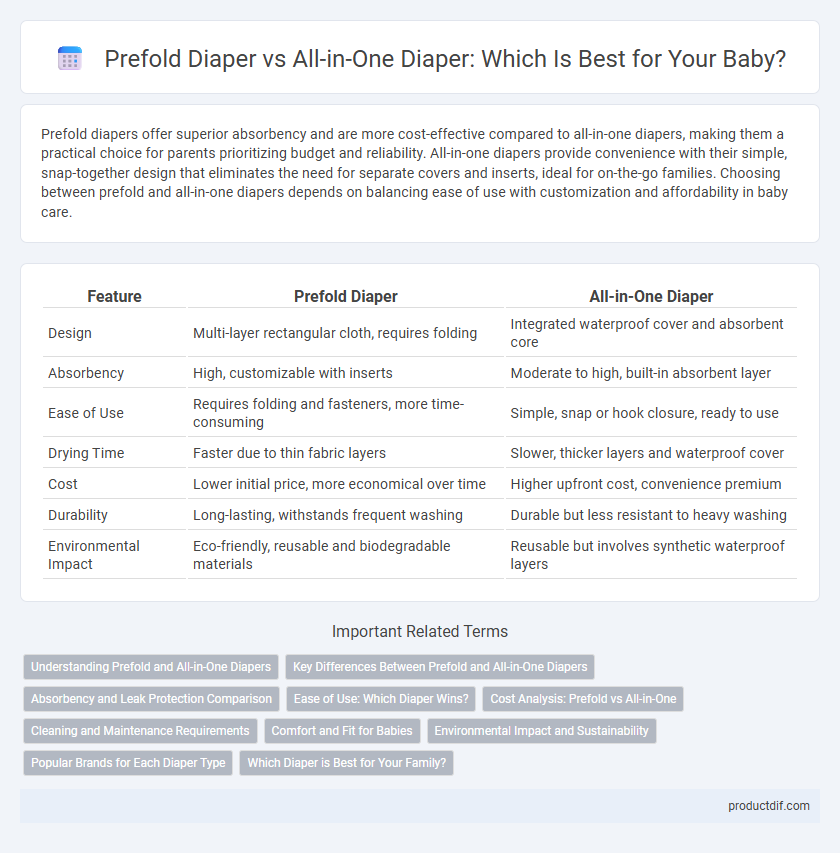Prefold diapers offer superior absorbency and are more cost-effective compared to all-in-one diapers, making them a practical choice for parents prioritizing budget and reliability. All-in-one diapers provide convenience with their simple, snap-together design that eliminates the need for separate covers and inserts, ideal for on-the-go families. Choosing between prefold and all-in-one diapers depends on balancing ease of use with customization and affordability in baby care.
Table of Comparison
| Feature | Prefold Diaper | All-in-One Diaper |
|---|---|---|
| Design | Multi-layer rectangular cloth, requires folding | Integrated waterproof cover and absorbent core |
| Absorbency | High, customizable with inserts | Moderate to high, built-in absorbent layer |
| Ease of Use | Requires folding and fasteners, more time-consuming | Simple, snap or hook closure, ready to use |
| Drying Time | Faster due to thin fabric layers | Slower, thicker layers and waterproof cover |
| Cost | Lower initial price, more economical over time | Higher upfront cost, convenience premium |
| Durability | Long-lasting, withstands frequent washing | Durable but less resistant to heavy washing |
| Environmental Impact | Eco-friendly, reusable and biodegradable materials | Reusable but involves synthetic waterproof layers |
Understanding Prefold and All-in-One Diapers
Prefold diapers consist of multiple layers of fabric sewn together, providing a customizable absorbency level and requiring separate waterproof covers, making them cost-effective and quick-drying. All-in-one diapers combine an absorbent core and waterproof outer layer into a single piece, offering convenience, ease of use, and minimal preparation or laundering steps. Parents choose prefold diapers for affordability and flexibility, while all-in-one diapers suit busy caregivers seeking simplicity and fast changes.
Key Differences Between Prefold and All-in-One Diapers
Prefold diapers consist of multiple layers of fabric that require folding and a waterproof cover, offering greater customization for absorbency and fit, while all-in-one diapers combine absorbent layers and a waterproof exterior in a single, convenient piece. Prefolds are typically more budget-friendly and faster to dry, making them ideal for frequent laundering, whereas all-in-one diapers provide easy use with no assembly, mimicking the convenience of disposable diapers. Key differences include ease of use, drying time, cost, and level of customization for sizing and absorbency.
Absorbency and Leak Protection Comparison
Prefold diapers consist of multiple layers of cotton fabric, offering customizable absorbency by folding to target leaks, while all-in-one diapers integrate absorbent layers with a waterproof outer shell, providing high convenience and consistent leak protection. Prefold diapers generally have superior absorbency due to thicker, natural fibers that wick moisture effectively but require a separate cover to prevent leaks. All-in-one diapers excel in leak protection with elastic leg gussets and snap closures, delivering a snug fit that minimizes blowouts compared to prefolds with covers.
Ease of Use: Which Diaper Wins?
Prefold diapers require folding and securing with a cover, offering customizable absorbency but demanding more effort and practice, making them less convenient for quick changes. All-in-one diapers combine absorbent layers and waterproof covers in a single piece, providing straightforward, no-fuss application ideal for busy parents. The all-in-one diaper wins in ease of use due to its simplicity and time-saving design.
Cost Analysis: Prefold vs All-in-One
Prefold diapers typically cost significantly less upfront, averaging $0.10 to $0.30 per diaper, while all-in-one diapers range from $0.80 to $1.50 each, making prefolds more budget-friendly for long-term use. However, prefold diapers require additional accessories like waterproof covers, incurring extra costs, whereas all-in-one diapers have built-in waterproof layers, streamlining the diapering process. Evaluating total expenses over time, including laundering resources and replacement frequency, prefold diapers often present a more economical choice for cost-conscious parents.
Cleaning and Maintenance Requirements
Prefold diapers require more hands-on cleaning, needing thorough pre-rinsing and careful folding after washing to maintain absorbency and avoid residue buildup. All-in-one diapers are designed for convenience, featuring a built-in waterproof layer that withstands machine washing without extra folding, but they may take longer to dry and require occasional deep cleaning to prevent odor. Both diaper types benefit from using gentle, fragrance-free detergents and avoiding fabric softeners to prolong fabric integrity and effectiveness.
Comfort and Fit for Babies
Prefold diapers offer superior breathability and customizable absorbency, enhancing comfort for babies with sensitive skin. All-in-one diapers provide a snug, adjustable fit with elastic leg cuffs and waistbands that prevent leaks while allowing easy movement. Both options prioritize comfort and fit, but prefolds excel in softness and airflow, whereas all-in-ones deliver convenience and secure containment.
Environmental Impact and Sustainability
Prefold diapers generate less waste due to their simple design and longer lifespan, making them a more sustainable choice compared to all-in-one diapers, which require more resources to manufacture and produce more landfill waste. Prefolds use less water and energy during washing, while all-in-one diapers, with their integrated inserts and waterproof layers, demand higher resource consumption and generate more synthetic material waste. Choosing prefold diapers supports environmental conservation by reducing plastic use and promoting reusable, biodegradable fabrics.
Popular Brands for Each Diaper Type
Popular prefold diaper brands include Rumparooz, Best Bottom, and Green Mountain Diapers, known for their affordable, reusable cotton layers that provide excellent absorbency and breathability. All-in-one diaper brands like GroVia, Thirsties, and BumGenius offer convenience with integrated absorbent inserts and waterproof covers, favored by parents seeking easy, one-step diapering solutions. Both types emphasize eco-friendly materials and adjustable fits to accommodate growing babies.
Which Diaper is Best for Your Family?
Prefold diapers offer cost-effective, customizable absorbency with easy washing and drying, making them ideal for families prioritizing budget and eco-friendliness. All-in-one diapers provide convenience and simplicity with built-in waterproof layers and no stuffing, perfect for busy parents seeking hassle-free diapering. Choosing the best diaper depends on your family's lifestyle, laundry routine, and preference for natural materials versus practicality.
Prefold diaper vs all-in-one diaper Infographic

 productdif.com
productdif.com